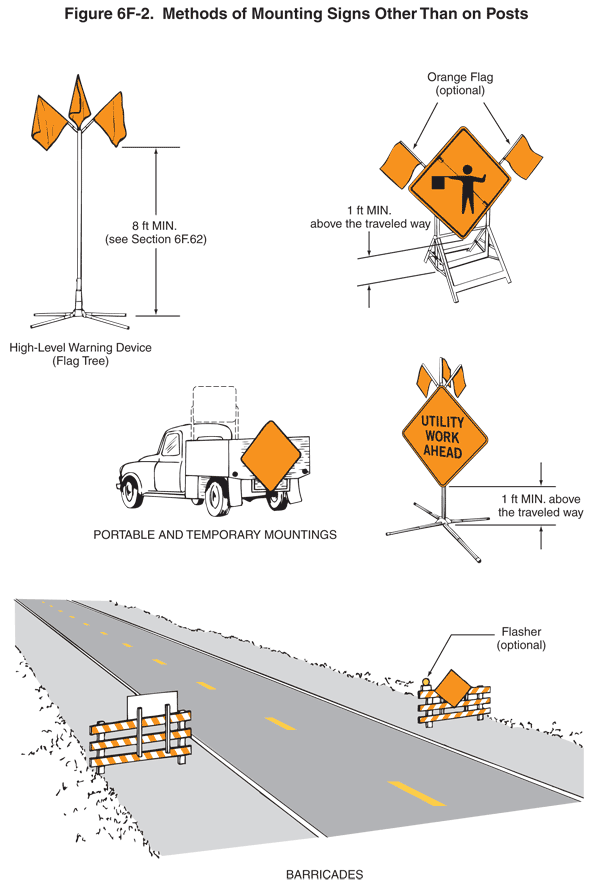2009 Edition Part 6 Figure 6F-2. Methods of Mounting Signs Other Than on Posts

Figure 6F-2. Methods of Mounting Signs Other Than on Posts
This figure shows five examples of methods of mounting signs other than on posts.
The first example is labeled as a "High-Level Warning Device (Flag Tree)." It is shown as a vertical pole that is mounted on four horizontal supports. On top of the pole, three orange flags are shown mounted equidistant apart from each other on short staffs that extend out from the top of the vertical pole at 45-degree angles. The distance from the roadway to the bottom of the flag material is labeled as "8 ft MIN." and this dimension is accompanied by a note that states "see Section 6F.62."
The second example shows a vertical rectangular frame support with four legs angled at a 45-degree angle. An orange diamond-shaped sign is shown attached to the frame. It shows the symbol of a silhouette of a person standing with the arm to the left (facing the viewer) extended horizontally away from their body and extending a flag staff horizontally with the flag hanging down. Their free arm is shown bent with the palm above shoulder level. The sign is shown with a diagonal black line, representing a fold line, from the center of the upper left side of the diamond to the center of the lower right side of the diamond. The distance from the bottom of the sign to the bottom of the supports is labeled as "1 ft MIN. above the traveled way." Orange flags on short staffs are shown attached at a 45-degree angle to both the upper left and upper right sides of the diamond-shaped sign. Both flags are labeled as "Orange Flag (optional)".
The third example is labeled as "Portable and Temporary Mountings." A pick-up truck is shown, with a blank orange diamond-shaped sign attached to the rear vertical panel of the truck. Immediately behind the cab of the pick-up truck, dotted lines are shown symbolizing two vertical supports and a horizontal rectangle in the shape of a sign attached to the vertical supports.
The fourth example shows an orange diamond-shaped sign with a black border and letters with the words "UTILITY WORK AHEAD" in three lines mounted on a vertical pole that is mounted on four horizontal supports. The distance from the bottom of the sign to the bottom of the supports is labeled as "1 ft MIN. above the traveled way." At the top of the sign, three orange flags are shown mounted equidistant apart from each other on short staffs that extend out from the top of the vertical pole at 45-degree angles.
The fifth example is labeled as "Barricades." A section of a two-lane roadway with shoulders on each side is shown in perspective view, with a broken yellow line separating the two opposing lanes and a solid white line separating each shoulder from the adjacent lane. On the left side of the figure, a three-rail orange and white striped horizontal barricade is shown on the shoulder, placed to the right of the approaching traffic lane. The back of the barricade is visible and shows two vertical supports attached to the barricade and supporting a horizontal rectangular sign, which is shown facing the oncoming traffic lane. On the right side of the figure, another three-rail orange and white striped horizontal barricade is shown placed on the shoulder to the right of the travel lane. The front of the barricade is visible, and a yellow flasher labeled "(optional)" is shown attached to the top-left of the top rail. A blank orange diamond-shaped sign is shown attached to the front of the barricade. On both barricades, the stripes on the rails are shown as diagonally oriented, downward toward the roadway and upward away from the roadway when viewed by approaching traffic.
